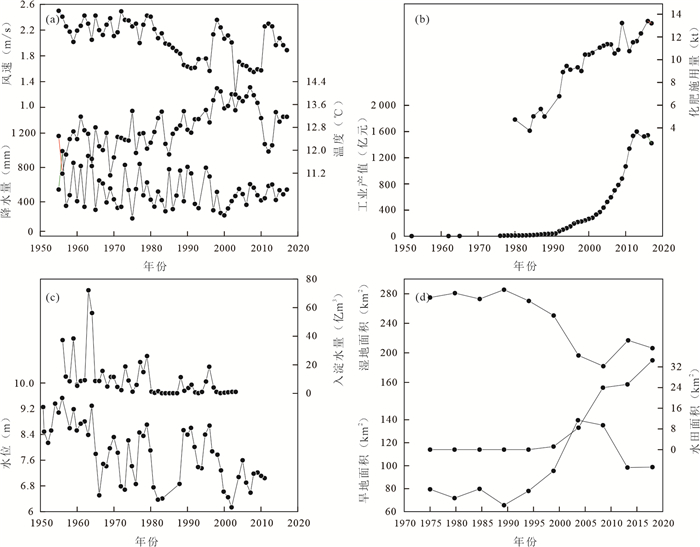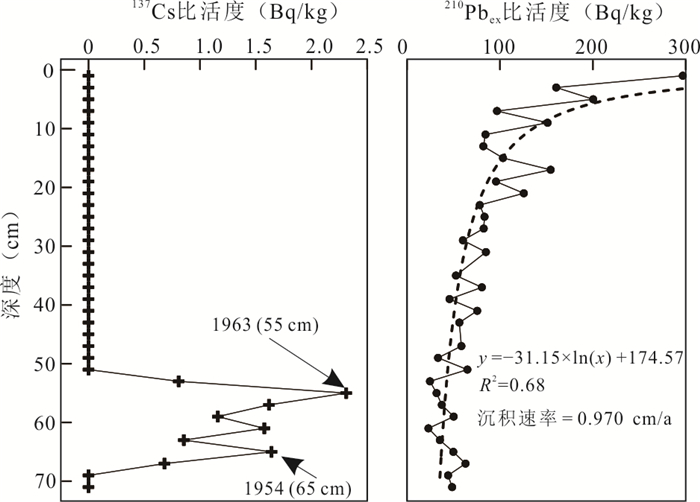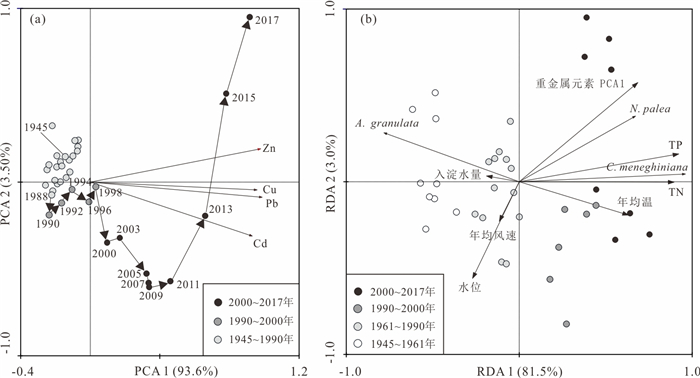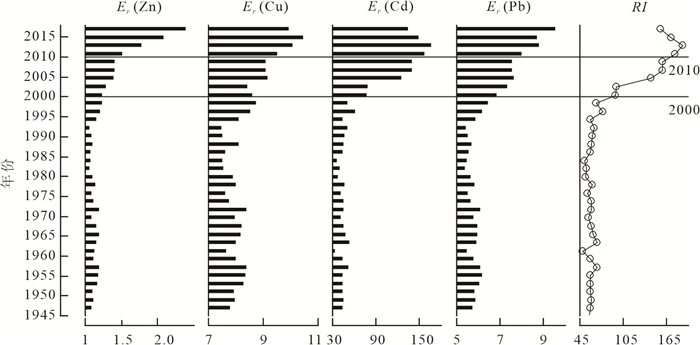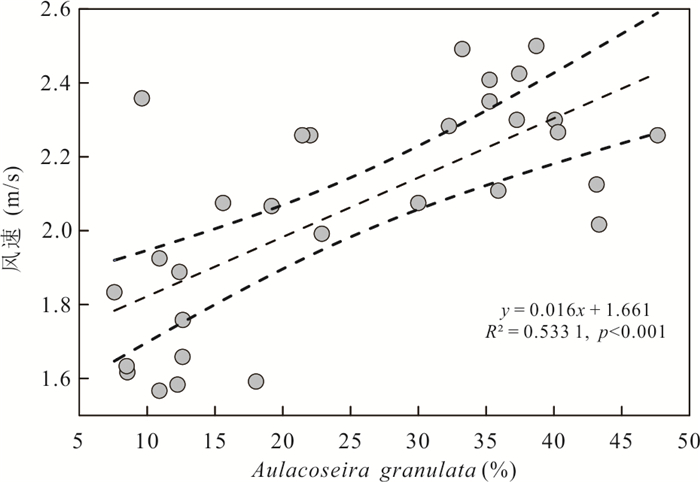A 70 Year Sedimentary Record of Eco-Environment Changes in Baiyangdian Lake and Its Influencing Factors
-
摘要: 基于白洋淀北部沉积岩心210Pb和137Cs测年、重金属元素、营养元素、粒度和硅藻优势属种分析,结合水文、气候以及保定市和安新县社会经济统计资料,重建了白洋淀近70年以来的生态环境演化历史,并探讨了影响硅藻优势属种演替的主要驱动因素.结果表明:1960年之前,重金属和营养元素处于较低的水平,硅藻属种以Aulacoseira granulata为主,反映湖泊生态环境处于自然演化阶段;1960年前后,由于受到上游水文调控的影响,白洋淀TP和TN含量开始缓慢增加,富营养指示种Cyclotella meneghiniana明显增加;1960~1990年,TP和TN含量明显升高,反映快速农业化进程中营养物质输入增加,但重金属含量仍保持在较低的水平,硅藻属种以A.granulata和C.meneghiniana为优势组合;1990年以来,流域工农业活动的快速发展导致重金属和营养盐富集,尤其是2000年以后,重金属和营养盐富集进一步加剧,此时硅藻组合也发生了重大转变,由1990年前的A.granulata优势种转变为1990年后的C.meneghiniana优势种,重金属耐受种Nitzschia palea也自2000年以来开始持续增加.冗余分析表明沉积物重金属、TP、TN、温度、风速、入淀水量和水位是影响白洋淀近70年以来3个硅藻优势属种演替的显著因子,其中重金属和营养是硅藻组合演替的主要驱动因素,水文过程、温度和风速是硅藻组合演替的重要诱因.Abstract: Based on sedimentary proxies (i.e., 210Pb and 137Cs dating, heavy metal nutrient and elements, particle size and diatom dominant species) from sediment core in the northern part of Baiyangdian Lake and documentary date (i.e., hydrology, climate, economic and society statistic from Baoding city and Anxin county), this study reconstructed the eco-environment changes of Baiyangdian Lake during the past 70 years and discussed the main driving factors affecting the succession of dominant diatom species.The results showed heavy metals and nutrients were of lower levels, and the diatom was dominated by Aulacoseira granulate before 1960, which indicated that the lake ecology was in the stage of natural evolution.Around 1960, influenced by hydrological control upstream, TP and TN content in Baiyangdian Lake started to increase slowly, and the indicator species of eutrophication, Cyclotella meneghiniana, increased significantly.Between 1960 and 1990, TP and TN content rose significantly, indicating more nutrient input in the rapid process of agriculturalization, however, the content of heavy metals still remained at a lower level. The diatom assemblages were characterized by the codominance of A. granulate and C. meneghiniana. After 1990, accelerated industrial and agricultural activitiesenriched heavy metals and nutrients, especially after 2000, such enrichment became even more significant.At which point diatom assemblages went through material changes: the dominant species shifted from A. granulate before 1990 to C. meneghiniana after 1990; the heavy metal-tolerant species Nitzschia palea hasbeen on the rise since 2000. According to the redundancy analysis, heavy metals, TP, TN, temperature, wind speed, hydrological conditions were significant factors influencing the succession of three diatom dominant speciesover the past 70 years in Baiyangdian. Heavy metals and nutrients were most important factors on diatom succession. Meanwhile, hydrological conditions, temperature and wind speed also imposed on diatom succession.
-
Key words:
- Baiyangdian Lake /
- heavy metal /
- nutrition /
- diatom /
- eco-environment /
- environmental geology
-
表 1 单因子及综合潜在生态风险评价指数与分级标准
Table 1. Individual indice and grades of potential ecological risk assessment
$ {E}_{r}^{i} $ 风险等级 RI 生态风险等级 $ {E}_{r}^{i} $ < 40 低等 RI < 150 低等 40≤$ {E}_{r}^{i} $ < 80 中等 150≤RI < 300 中等 80≤$ {E}_{r}^{i} $ < 160 较重 300≤RI < 600 重 160≤$ {E}_{r}^{i} $ < 320 重 RI≥600 严重 $ {E}_{r}^{i} $≥320 严重 -
Anderson, N. J., 2000. Diatoms, Temperature and Climatic Change. European Journal of Phycology, 35(4): 307-314. https://doi.org/10.1017/s0967026200002857 Battarbee, R. W., Jones, V. J., Flower, R. J., et al., 2002. Diatoms. In: Smol, J. P., Birks, H. J. B., Last, W. M., eds., Tracking Environmental Change Using Lake Sediments. Volume 3. Terrestrial, Algal, and Siliceous Indicators. Kluwer Academic Publisher, Dordrecht, 155-202. Bennion, H., Battarbee, R. W., Sayer, C. D., et al., 2011. Defining Reference Conditions and Restoration Targets for Lake Ecosystems Using Palaeolimnology: A Synthesis. Journal of Paleolimnology, 45(4): 533-544. https://doi.org/10.1007/s10933-010-9419-3 Chen, X., Yang, X. D., Dong, X. H., et al., 2013a. Environmental Changes in Chaohu Lake (Southeast, China) since the Mid 20th Century: The Interactive Impacts of Nutrients, Hydrology and Climate. Limnologica, 43(1): 10-17. https://doi.org/10.1016/j.limno.2012.03.002 Chen, X., Mao, X., Cao, Y. M., et al., 2013b. Use of Siliceous Algae as Biological Monitors of Heavy Metal Pollution in Three Lakes in a Mining City, Southeast China. Oceanological and Hydrobiological Studies, 42(3): 1-25. https://doi.org/10.2478/s13545-013-0079-6 Chen, X., McGowan, S., Xu, L., et al., 2016. Effects of Hydrological Regulation and Anthropogenic Pollutants on Dongting Lake in the Yangtze Floodplain. Ecohydrology, 9(2): 315-325. https://doi.org/10.1002/eco.1637 Cui, X. L., 1995. Investigation of Eutrophication Pollution Sources in Baiyangdian Lake. Environmental Ecology, 16(Suppl.): 17-18+27 (in Chinese). Dong, X. H., Yang, X. D., Chen, X., et al., 2016. Using Sedimentary Diatoms to Identify Reference Conditions and Historical Variability in Shallow Lake Ecosystems in the Yangtze Floodplain. Marine and Freshwater Research, 67(6): 803. https://doi.org/10.1071/mf14262 Gell, P., Tibby, J., Fluin, J., et al., 2005. Accessing Limnological Change and Variability Using Fossil Diatom Assemblages, South-East Australia. River Research and Applications, 21(2/3): 257-269. https://doi.org/10.1002/rra.845 Hakanson, L., 1980. An Ecological Risk Index for Aquatic Pollution Control: A Sedimentological Approach. Water Research, 14(8): 975-1001. https://doi.org/10.1016/0043-1354(80)90143-8 Hu, G. C., Xu, M. Q., Xu, Z. C., et al., 2011. Pollution Characteristic and Potential Risk Assessment of Heavy Metals in Surface Sediment from Fuhe River and Baiyangdian Lake, North China. Journal of Agro-Environment Science, 30(1): 146-153(in Chinese with English abstract). http://en.cnki.com.cn/Article_en/CJFDTOTAL-NHBH201101025.htm Jekel, H., 2005. Sustainable Water Management in Europe: The Water Framework Directive. In: Vogtmann, H., Dobretsov, N., eds. Transboundary Water Resources: Strategies for Regional Security and Ecological Stability. Springer, Netherlands, 121-127. Jiang, X., Jin, X. C., Yao, Y., et al., 2008. Effects of Biological Activity, Light, Temperature and Oxygen on Phosphorus Release Processes at the Sediment and Water Interface of Taihu Lake, China. Water Research, 42(8/9): 2251-2259. https://doi.org/10.1016/j.watres.2007.12.003 Krammer, K., Lange-Bertalot, H., 1986. Bacillariophyceae (1-4 Teil). In: Ettl, H., Gerloff, J., Heynig, H., eds., Süßwasserflora von Mitteleuropa, Vol. 2. Stuttgart/Jena, Gustav Fischer Verlag, 1-4. Li, Y. M., Zhao, Q., Feng, G. P., 2010. The Diatom Assemblages and Their Response to Different Environments of Baiyangdian Lake, China. Acta Ecological Sinica, 30(17): 4559-4570(in Chinese with English abstract). http://www.researchgate.net/publication/286728954_The_diatom_assemblages_and_their_response_to_different_environments_of_Baiyangdian_Lake_China Li, Z. Q., Liu, J. Z., Wang, W. X., 2002. Analysis of the Causes of Baiyangdian Sediment Accumulation. Hebei Water Resources and Hydropower Technology, (2): 31-32 (in Chinese with English abstract). Liu, E. F., Shen, J., Liu, X. Q., et al., 2005. Variation Characteristics and Pollution History of Heavy Metals and Nutrients in Sediments of Taihu Lake. Science in China (Series D: Earth Science), 35(Suppl. II): 73-80(in Chinese with English abstract). Liu, S. C., Wang, H. H., Tian, K., et al., 2020. Ecological Environmental Changes and Influencing Analysis in Baiyangdian Lake. Journal of Agro-Environment Science, 39(5): 1060-1069(in Chinese with English abstract). Liu, X., Shi, B., Meng, J., et al., 2019. Spatio-Temporal Variation Characteristics of Water Eutrophication and Sediment Pollution in Baiyangdian Lake. Environmental Science, 41(5): 2127-2136 (in Chinese with English abstract). Munendra, S., German, M., Singh, I. B., 2003. Geogenic Distribution and Baseline Concentration of Heavy Metals in Sediments of the Ganges River, India. Journal of Geochemical Exploration, 80(1): 1-17. doi: 10.1016/S0375-6742(03)00016-5 Nogueira, M. G., 2000. Phytoplankton Composition, Dominance and Abundance as Indicators of Environmental Compartmentalization in Jurumirim Reservoir (Paranapanema River), São Paulo, Brazil. Hydrobiologia, 431: 115-128. doi: 10.1023/A:1003769408757 Qin, Y. M., Gong, J., Gu, Y. S., et al., 2018. Ecological Monitoring and Environmental Significance of Testate Amoebae in Subalpine Peatlands in West Hubei Province, China. Earth Science, 43(11): 4036-4045(in Chinese with English abstract). http://en.cnki.com.cn/Article_en/CJFDTotal-DQKX201811021.htm Ritchie, J. C., McHenry, J. R., 1990. Application of Radioactive Fallout Cesium-137 for Measuring Soil Erosion and Sediment Accumulation Rates and Patterns: A Review. Journal of Environmental Quality, 19(2): 215-233. https://doi.org/10.2134/jeq1990.00472425001900020006x Smol, J. P., 2010. The Power of the Past: Using Sediments to Track the Effects of Multiple Stressors on Lake Ecosystems. Freshwater Biology, 55(Suppl.1): 43-59. https://doi.org/10.1111/j.1365-2427.2009.02373.x Song, Z. H., 2005. Analysis of Hydrological Characteristics in Baiyangdian Basin. Hebei Water Resources, 9: 10-11 (in Chinese). Stager, J. C., Hecky, R. E., Grzesik, D., et al., 2009. Diatom Evidence for the Timing and Causes of Eutrophication in Lake Victoria, East Africa. Hydrobiologia, 636(1): 463-478. https://doi.org/10.1007/s10750-009-9974-7 Tockner, K., Stanford, J. A., 2002. Riverine Flood Plains: Present State and Future Trends. Environmental Conservation, 29(3): 308-330. https://doi.org/10.1017/s037689290200022x Wang, J., Gao, G., Pei, Y. S., et al., 2010. Sources and Transformations of Nitrogen in the Fuhe River of the Baiyangdian Lake. Environmental Science, 31(12): 2905-2910(in Chinese with English abstract). http://www.ncbi.nlm.nih.gov/pubmed/21360878 Yang, C. X., 2010. Analysis on the Deposited Quantity Variation and Its Influenced Factors in Bayangdian. Ground Water, 32(2): 110-112(in Chinese with English abstract). http://en.cnki.com.cn/Article_en/CJFDTOTAL-DXSU201002045.htm Yang, W., Tian, Y. Y., Zhang, Z. H., et al., 2019. Evolution of Phytoplankton Community and Biotic Integrity in Baiyangdian Lake in Recent 60 Years. Environmental Ecology, 8(1): 1-9 (in Chinese with English abstract). Yang, X. D., Anderson, N. J., Dong, X. H., et al., 2008. Surface Sediment Diatom Assemblages and Epilimnetic Total Phosphorus in Large, Shallow Lakes of the Yangtze Floodplain: Their Relationships and Implications for Assessing Long-Term Eutrophication. Freshwater Biology, 53(7): 1273-1290. https://doi.org/10.1111/j.1365-2427.2007.01921.x Yang, Y., Yin, X. N., Yang, Z. F., et al., 2018. Detection of Regime Shifts in a Shallow Lake Ecosystem Based on Multi-Proxy Paleolimnological Indicators. Ecological Indicators, 92(7): 312-321. https://doi.org/10.1016/j.ecolind.2017.05.059 Yu, S. C., Yu, D. Q., Wang, L. C., et al., 2019. Remote Sensing Study of Dongting Lake Bearch Changes before and after Operation of Three Gorges Reservoir. Earth Science, 44(12): 4275-4283(in Chinese with English abstract). http://en.cnki.com.cn/Article_en/CJFDTotal-DQKX201912037.htm Yuan, Y., Yan, D. H., Wang, H., et al., 2013. Attributive Analysis on Evolution of Inflow to Baiyangdian Wetland. Water Resources and Hydropower Engineering, 44(12): 1-23 (in Chinese with English abstract). http://en.cnki.com.cn/Article_en/CJFDTOTAL-SJWJ201312001.htm Zeng, L. H., Ning, D. L., Xu, L., et al., 2015. Sedimentary Evidence of Environmental Degradation in Sanliqi Lake, Daye City (A Typical Mining City, Central China). Bulletin of Environmental Contamination and Toxicology, 95(3): 317-324. https://doi.org/10.1007/s00128-015-1606-5 Zhang, S. Z., Tian, J. W., Li, G. B., 2007. Ecological Problems and Restoration Measures of Baiyangdian Wetland. Bulletin of Soil and Water Conservation, 27(3): 146-150(in Chinese with English abstract). http://en.cnki.com.cn/Article_en/CJFDTOTAL-STTB200703032.htm Zhang, T., Liu, J. L., Wang, X. M., 2010. Causal Analysis of the Apatial-Temporal Variation of Water Quality in Baiyangdian Lake. Acta Scientiae Circumstantiae, 30(2): 281-267 (in Chinese with English abstract). http://www.oalib.com/paper/1592464 Zhao, X. F., Zhang, X. R., 2019. Study on Policy Tool Selection in Water Pollution Control in Xiong'an New Area-Based on the Policy Text of Baiyangdian Basin (1984-2018). Journal of the Party School of the CPC Ningbo Municipal Committee, 41(5): 103-111 (in Chinese). Zhu, J. F., Zhou, Y., Wang, S. X., et al., 2019. Analysis of Changes of Baiyangdian Wetland from 1975 to 2018 Based on Remote Sensing. Journal of Remote Sensing, 23(5): 971-986 (in Chinese with English abstract). 崔秀丽, 1995. 白洋淀水体富营养化污染源调查. 环境科学, 16(增刊): 17-18+27. https://www.cnki.com.cn/Article/CJFDTOTAL-HJKZ5S1.006.htm 胡国成, 许木启, 许振成, 等, 2011. 府河-白洋淀沉积物中重金属污染特征及潜在风险评价. 农业环境科学学报, 30(1): 146-153. https://www.cnki.com.cn/Article/CJFDTOTAL-NHBH201101025.htm 李亚蒙, 赵琦, 冯广平, 等, 2010. 白洋淀硅藻分布及其与水环境的关系. 生态学报, 30(17): 4559-4570. https://www.cnki.com.cn/Article/CJFDTOTAL-STXB201017005.htm 李振卿, 刘建芝, 王卫喜, 2002. 白洋淀泥沙淤积成因分析. 河北水利水电技术, (2): 31-32. doi: 10.3969/j.issn.1672-9900.2002.02.030 刘恩峰, 沈吉, 刘兴起, 等, 2005. 太湖沉积物重金属和营养盐变化特征及污染历史. 中国科学(D辑: 地球科学), 35(增刊II): 73-80. https://www.cnki.com.cn/Article/CJFDTOTAL-JDXK2005S2008.htm 刘世存, 王欢欢, 田凯, 等, 2020. 白洋淀生态环境变化及影响因素分析. 农业环境科学学报, 39(5): 1060-1069. https://www.cnki.com.cn/Article/CJFDTOTAL-NHBH202005016.htm 刘鑫, 史斌, 孟晶, 等, 2019. 白洋淀水体富营养化和沉积物污染时空变化特征. 环境科学, 41(5): 2127-2136. https://www.cnki.com.cn/Article/CJFDTOTAL-HJKZ202005016.htm 秦养民, 巩静, 顾延生, 等, 2018. 鄂西亚高山泥炭地有壳变形虫生态监测及对水位的指示意义. 地球科学, 43(11): 4036-4045. doi: 10.3799/dqkx.2018.599 宋中海, 2005. 白洋淀流域水文特性分析. 河北水利, 9: 10-11. https://www.cnki.com.cn/Article/CJFDTOTAL-HBLS200509008.htm 王珺, 高高, 裴元生, 等, 2010. 白洋淀府河中氮的来源与迁移转化研究. 环境科学, 31(12): 2905-2910. https://www.cnki.com.cn/Article/CJFDTOTAL-HJKZ201012015.htm 杨春霄, 2010. 白洋淀入淀水量变化及影响因素分析. 地下水, 32(2): 110-112. doi: 10.3969/j.issn.1004-1184.2010.02.044 杨薇, 田艺苑, 张兆衡, 等, 2019. 近60年来白洋淀浮游植物群落演变及生物完整性评价. 环境生态学, 8(1): 1-9. https://www.cnki.com.cn/Article/CJFDTOTAL-HJSX201908002.htm 余姝辰, 余德清, 王伦澈, 等, 2019. 三峡水库运行前后洞庭湖州滩面积变化遥感认识. 地球科学, 44(12): 4275-4283. doi: 10.3799/dqkx.2019.182 袁勇, 严登华, 王浩, 等, 2013. 白洋淀湿地入淀水量演变归因分析. 水利水电技术, 44(12): 1-23. doi: 10.3969/j.issn.1000-0860.2013.12.001 张素珍, 田建文, 李贵宝, 2007. 白洋淀湿地面临的生态问题及生态恢复措施. 水土保持通报, 27(3): 146-150. doi: 10.3969/j.issn.1000-288X.2007.03.032 张婷, 刘静玲, 王雪梅, 2010. 白洋淀水质时空变化及影响因子评价与分析. 环境科学学报, 30(2): 281-267. https://www.cnki.com.cn/Article/CJFDTOTAL-HJXX201002006.htm 赵新峰, 张欣蕊, 2019. 雄安新区水污染治理中的政策工具选择研究——基于白洋淀流域政策文本(1984~2018). 中共宁波市委党校学报, 41(5): 103-111. doi: 10.3969/j.issn.1008-4479.2019.05.015 朱金峰, 周艺, 王世新, 等, 2019. 1975年~2018年白洋淀湿地变化分析. 遥感学报, 23(5): 971-986. https://www.cnki.com.cn/Article/CJFDTOTAL-YGXB201905017.htm -









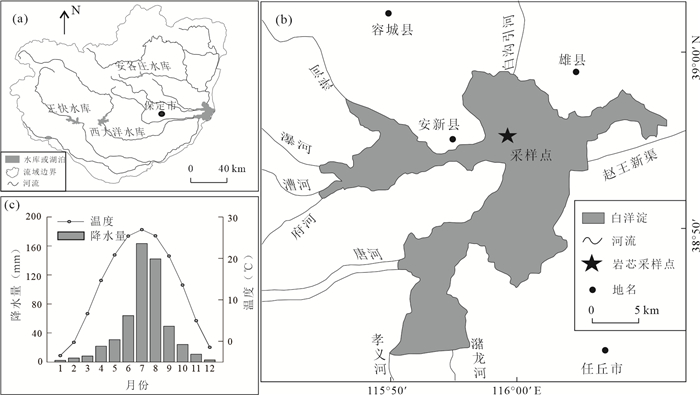
 下载:
下载:
